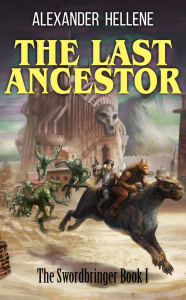Book Review: Hyperion by Dan Simmons
[image error]
Every so often I read a sci-fi novel that makes me rethink the genre and what it can do. Dune was one. A Princess of Mars was another. Hyperion is a third.
In the far future, humanity is spread into the cosmos, colonizing planets linked by teleporters called Farcasters–this is called the Web and it is run by the Hegemony of Man. High technology reigns, enabled by the AIs who run a virtual world of information called the TechnoCore.
Centuries ago, the AI seceded from humanity to live a separate existence, but still aids humans via technology, information sharing on the datumsphere–basically the Internet–and advising on important matters by using its predictive powers and algorithms. Additionally, every human has a comlog, a wearable biometric device, and several have neural shunts for direct access to the datumsphere. They weren’t enough to save Old Earth from being destroyed by a subterranean black hole a few centuries back, but they’ve proven to be friendly, albeit inscrutable, allies.
And then there’s the planet of Hyperion.
A backwater world outside of the Web–that is, not linked by Farcaster–and even outside of the Protectorate–worlds next in line for Web-status–Hyperion is in the Outback, and is a wildcard that stymies the AIs predictive abilities.
It is also home to the Time Tombs, huge structures like a Sphinx and an Obelisk and a Crystal Tower that are moving backwards through time. The Tombs release an anti-entropic field that flares up from time to time.
However, more dangerous than that, in the Valley of the Time Tombs there lives a creature called the Shrike, a three-meter tall, four-armed, red-eyed metal being covered in thorns and spikes. It appears where he will in the Valley, and few who see it live.
[image error]
And now, with the Hegemony being invaded by the hostile Ousters, humans who left the Hegemony nearly a millennium ago, the Shrike is starting to range outside of the Valley.
A cult has built up around the Shrike over the centuries, and they conduct pilgrimaged to the Valley, always seven at a time. It is said the Shrike will grant one pilgrim a wish and impale the rest upon its tree of pain.
In this mix, the TechnoCore advises Hegemony CEO Meina Gladstone about seven individuals who should be selected to go on the pilgrimage despite the war, as one of them may hold the key to saving humanity.
But the Time Tombs are slowly opening, that is, coming into phase with the present flow of time. And nobody knows what will happen when that occurs . . . not even the TechnoCore
[image error]Dan Simmons
There’s a lot going on in Hyperion, but Simmons handles it deftly. The storytelling is diegetic, so expect some confusion the first few chapters until you read on and begin to understand the word. But Simmons is such an evocative writer with a minimum of words, you won’t mind. Simmons is not flowery, but economical; he chooses the perfect words and creates a certain type of poetry with his prose, crafting some passages of heartbreaking poignancy.
He also does a lot “wrong,” treating Hyperion–book one in his four-part series–like Chaucer’s Canterbury Tales, interspersing they seven pilgrims’ trip with each telling their story of their prior experience with Hyperion and the Shrike.
Criticisms on this basis are wrong. The flashbacks work as Simmons slowly unravels the mystery and reveals why each pilgrim is there.
They are Het Mesteen, a Templar from the world of God’s Grove, True Voice of the Tree, whose treeship Yggdrasil is war brought the seven to Hyperion . . . the Consul, former Hegemony representative on Hyperion and harboring a secret family history . . . Brawne Lamia, a private eye from Lusus whose former lover, a cybrid with the reconstructed personality of poet John Keats, was wanted by the TechnoCore, and granted refuge by the Shrike Church . . . Colonel Fedmahn Kassad, war hero of FORCE, the Hegemony’s military, who seeks out the Shrike to confront it . . . the poet Martin Silenus who lived on Hyperion long ago in the artists’ city created by an exiled king, and for whom the Shrike is his muse . . . Father Lenar Hoyt, a Catholic priest from the world of Pacem, who came to Hyperion earlier to seek a colleague in self-imposed exile . . . and scholar Sol Weintraub, a professor from Barnard’s World, whose daughter Rachel was a researcher of the Time Tombs when a meeting with the Shrike caused her to age backwards every day; Sol, compelled by disturbing dreams, has brought baby Rachel on the pilgrimage with him . . .
. . . and one of them is an Ouster spy.
[image error]Art by Aleksandar Obradd
There is so much packed into Hyperion. It’s like a less dense Dune, touching on religion, politics, and philosophy but keeping plenty of sci-fi action and adventure; what I call the “space stuff.”
It’s so imaginative too–houses where each room spans worlds via Farcaster; strange and beautifulw planets; the concept of “time debt” as a result of space travel.
And that cover by Gary Ruddell is perfect. I bought the paperback just for that.
Hyperion is a must-read for any fan of sci-fi old and new. Simmons has crafted a serious and engaging work light-years beyond the third-hand and third-rate fluff that passes for sci-fi nowadays. This book will reinvigorate your love for the genre. We need more writers of gravitas, intellect, and skill like Simmons.
The cover to Hyperion was one of the inspirations for the cover to The Last Ancestor, both in font style and the fact that it actually depicts stuff from the book. No generic covers here! Buy it on Amazon.




